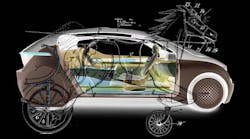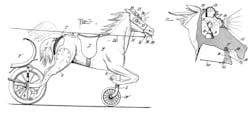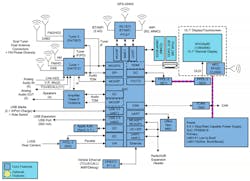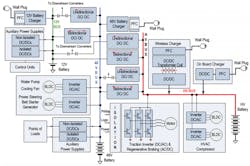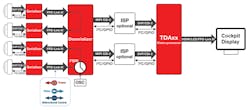Horseless to Humanless: The Electrification of Vehicle Technology
Download this article in PDF format.
Although it was largely unnoticed by the public, 2017 marked the start of perhaps the biggest shift in day-to-day transportation since large-scale manufacturing of cars began in 1901. That was when Audi introduced the A8, which was claimed to be the first vehicle capable of SAE Level 3 autonomous operation. Why is this significant? During Level 3 operation, the driver can take their eyes off the road and let the vehicle drive itself.
The A8 can only enter Level 3 operation under tightly restricted driving conditions, and it’s powered by an internal combustion engine. Still, it represents a huge step in the roadmap to a fully autonomous, fully electric vehicle, which operates without human assistance and where every mechanical and hydraulic function has been replaced by its electrical equivalent.
Sponsored Resources:
1. Don’t Scare The Horses. The first horseless carriage was the beginning of the end for horse-powered transportation. Attempts to smooth the transition included this 1904 patent for attaching a fake horse to the front wheels. (Source: Google Patents)
The movement toward vehicle electrification began in the earliest days of the horseless carriage (Fig. 1). The earliest vehicles used kerosene lamps for lighting and a naked flame to ignite the fuel mixture, but that didn’t last long. Among the highlights:
- Electromechanical distributor and vacuum advance to electronic ignition timing
- Carburetors to electronic fuel injectors and closed-loop engine control
- Oil lamps to incandescent and later LED lamps
- Hydraulically controlled transmission to electronic transmission
Consumer demand continues to increase for convenience and safety features like electric seats, mirrors, cruise control, LED lighting, antilock braking (ABS), and electronic stability control (ESC). But the next stage in automotive electronic content is expected to revolve around three words: Connected, Autonomous, and Electric.
Connected Vehicles: Bringing the World to the Automobile
GM’s OnStar, launched in 1996, was one of the first services to provide data and voice connectivity between a vehicle and the outside world. More recently, broadband wireless has put the vehicle in touch with a vast range of external services: GPS, streaming audio and video, weather, traffic information, etc. These are grouped with traditional radio under the heading of infotainment, which also includes the audiovisual components of advanced driver-assistance systems (ADAS), discussed in more detail below.
In the “digital cockpit,” the discrete gauges disappear as applications processors provide graphical representations of analog instruments. Additional features include active maps for navigation, and head-up displays (HUDs) to display critical information at eye level so that the driver can concentrate on the road ahead.
A variety of electronic technologies come together to help the vehicle add infotainment features. The reference design in Figure 2 includes multiple TI parts: the DRA718 “Jacinto” applications processor; a high-definition touchscreen display; high-speed wired and wireless communication; as well as familiar blocks such as Wi-Fi, digital-audio-broadcast (DAB) interfaces, and Class-D audio amplifiers.
2. The DR71x infotainment applications processor forms the basis of a low-cost reference design that can support multiple video and graphics formats. (Source: TI Designs: “Cost-Effective In-Vehicle Infotainment System Reference Design” PDF)
In the near future, expect to see vehicles communicating in real time with each other and with their environment via vehicle-to-vehicle (V2V) and vehicle-to-infrastructure (V2I) modules that are now emerging. The V2V function will reduce accidents, for example, by exchanging speed information and braking status, or alerting vehicles on a main road about other vehicles about to enter from a side road. V2V will also allow vehicle platooning, in which multiple closely spaced vehicles travel together in a high-speed convoy, a technique that yields significant fuel savings. V2I will enable features such as alerts about accidents or traffic congestion, including synchronization of signals to speed traffic flow.
HEVs and EVs Spur HV Power Electronics Development
Increasingly stringent emissions and fuel-economy regulations continue to be implemented worldwide, driving the adoption of hybrid and fully electric vehicles. Concern over global warning has spurred attempts to reduce or eliminate internal combustion engines (ICEs). In fact, efforts are underway in California, China, and several European countries to ban such vehicles over the next several decades.
3. Hybrid electric vehicles replace an increasing number of mechanical and hydraulic functions with their electrical equivalents, culminating in the fully electric vehicle. (Source: “Get on the fast-track to automotive system innovation with Texas Instruments” PDF)
HEVs and EVs have garnered significant publicity (and market share) since the first Toyota Prius rolled off the production line in 1997. Hybrid and especially electric vehicles replace many mechanical blocks with electronic ones and constitute a primary growth market for new electronic content. We can divide HEV/EV technology into six stages (Fig. 3).
For electronic components, HEVs and EVs place the primary emphasis on energy-efficient energy conversion between ac and dc power (Fig. 4). All types of topologies are included:
- DC-DC converters power low-voltage electronics.
- DC-AC converters drive electric motors, including powertrains.
- AC-DC converters recharge vehicles from both standard residential outlets and high-power charging stations.
4. The HEV/EV requires numerous types of high-voltage converters, including unidirectional and bidirectional DC-DC topologies. (Source: TI Training video: “How to Design Multi-kW DC/DC Converters for Electric Vehicles (EVs) – EV System Overview”)
Although an HEV/EV has intermediate dc buses that supply voltages of 48 V and 12 V to many systems, the basic system voltage comes from a lithium-ion (Li-ion) battery pack that stacks multiple Li-ion cells to generate over 400 V, so an HEV/EV requires the use of specialized high-voltage components and techniques.
Safety is a top priority in high-voltage designs. Preventing humans from exposure to dangerous voltages and currents is of paramount importance, of course, but other circuits must be protected against HV-related hazards such as overvoltage, overcurrent, power spikes, or electromagnetic noise.
Ensuring that a system is safe involves every aspect of the design process: material selection, process development, circuit design, packaging, and qualification. Specialized devices, such as the TMS570 Hercules line of microcontrollers (MCUs) are designed for the safe control of electrical systems: they include features such as dual lockstep CPUs, self-test, and error correction. Another MCU family, the C2000, is optimized for high-speed, real-time motor control.
Designing the DC-AC inverter for the main traction motor is particularly challenging in high-performance EVs such as Tesla’s Model S, because it must switch power levels greater than 300 kW. Both insulated-gate bipolar transistors (IGBTs) and silicon MOSFETs have been used for power switching, but gallium-nitride (GaN) transistors are theoretically capable of switching 1 kV and more at megahertz frequencies, so they’re becoming the preferred solution.
What of the battery pack itself? Although Li-ion is the preferred chemistry for HEV and EV batteries, Li-ion batteries have a relatively small safe operating area (SOA). Overcharging and other conditions can have undesirable consequences ranging from reduced battery life to catastrophic fires, so EV battery packs require precision battery-management systems (BMS). A typical BMS measures cell voltages, cell current, and temperature to balance the charge distribution between cells and ensure long battery life.
Once the battery size has been fixed, the maximum range of an electric vehicle depends on its power consumption. A light foot on the throttle helps, but the electrical components must be designed for maximum energy efficiency, from the motor to the digital clock. This requirement potentially affects all aspects of component design.
Components must consume minimum power when operating and transition into a low-power “sleep” mode when not needed. Many more complex parts, such as ASICs and microcontrollers, can also shut down power-hungry functional blocks if they’re not used in a particular operation.
Incidentally, electric vehicles aren’t only on the interstate—they’re at the track, too. The Formula-E racing series, now in its fourth season with 12 races on the calendar, has a dual purpose: raise awareness of electric vehicles, and improve technology across a broad front, following the well-known maxim “racing improves the breed.” The series is pursuing a multiyear program of development. In Season One, all teams used identical vehicles, but successive seasons have gradually opened more areas to competition. From Season Two on, teams could change their e-motor, gearbox, and inverter, and new chassis are slated for next season.
Autonomous Vehicles: The End of the Road for Human Drivers?
Longer term, the rise of autonomous (self-driving) vehicles is another trend that promises great things for electronic component suppliers, but one that could herald a seismic shift in the traditional automotive industry.
With the projected widespread availability of autonomous vehicles, treated by consumers as a service that’s summoned on demand from a smartphone, some have even predicted that human-driven vehicles might be legislated out of existence within 20 years, banished to a few privately owned roads and race tracks.
Worrying that humans are too dangerous ironically brings us full circle. In the 1890s, people also worried about humans behind the wheel. Back then, though, it was because there wasn’t a team of horses with the innate intelligence to compensate for human mistakes!
5. SAE J3016 defines six levels of autonomous driving from Level 0 (No Automation) to Level 5 (Full Automation) (Source: nhtsa.gov)
The Society of Automotive Engineers (SAE) has divided automated driving into five levels (Fig. 5) in its SAE J3016 standard.
Each succeeding level adds features. Levels 0, 1, and 2 require that a human driver monitor driving conditions and take over when necessary, while the higher levels progressively reduce the level of human involvement:
- Level 0 (No Automation)
- Level 1 (Driver Assistance): Adds simple features such as cruise control.
- Level 2 (Partial Automation): Includes some advanced features such as lane-keeping assistance, acceleration and merging, and collision avoidance. Several production vehicles qualify as Level 2.
- Level 3 (Conditional Automation): A vehicle can assume driving control in all respects, but humans must take control when prompted by the system. The Audi A8 claims Level 3 capability.
- Level 4 (High Automation): The vehicle may request that a human driver take over, but doesn’t require the human to respond. If the driver ignores the request, a Level 4 vehicle must still respond safely.
- Level 5 (Full Automation): The autonomous vehicle is capable of total control at all times.
Helped by the massive increase in high-speed automotive networks, many of the building blocks needed for autonomous operation are starting to appear under the category of ADAS. ADAS technologies include adaptive cruise control, collision-avoidance, and parking-assistance technologies, among others. The ADAS market is projected to exceed $67 billion by 2025, with a compound annual growth rate (CAGR) of 19.0%.
ADAS requires many functional blocks, including sensors that capture information about the surrounding environment. Many ADAS blocks are already in vehicles with human drivers. Vision sensors, for example, can replace traditional rear-view and side-view mirrors and give the driver a 360-deg. view via the cockpit display. The vision system in an autonomous vehicle must also detect obstacles, interpret road signs, and work closely with sensors outside the visible light range. Ultrasonic, radar, and LiDAR sensors each have advantages and disadvantages in certain conditions.
ADAS requires the tight integration of multiple HD images into a single 360-deg. view. For real-time response, the system must be optimized for maximum throughput.
Figure 6 shows the block diagram of an ADAS vision system with four cameras. The design contains the following functional blocks: serializer, deserializer hub, image signal processor (ISP), and an application processor. It uses TI’s high-speed FPD-Link III, allowing high-speed video, power, and bidirectional control signals to be sent over a single coaxial cable. Like the vast majority of automotive electronic systems, the design requires a combination of many functions: high-definition image capture, high-speed data communication, power over coax (PoC), and vision processing.
6. An ADAS vision system must capture synchronized images from multiple remote cameras and transmit them to a central vision processor for aggregation and cockpit display. (Source: “Stepping into next-generation architectures for multi-camera operations in automobiles” PDF)
TI has a complete set of solutions for ADAS vision systems, including the TDAx system-on-chip (SoC) family. It’s a scalable family of devices that meet ADAS and other vision-system requirements.
Many ADAS features are already on the road in high-end vehicles. The 2018 Mercedes S-class, for example, features Level 2 autonomous driving and includes ADAS functions for blind-spot assist; collision-prevention assist, including forward collision; active lane-keeping assist; and lane-departure warning.
The Ever-Present Safety Factor
We mentioned safety in the context of electric vehicles, but the automotive market imposes stringent safety, quality, and reliability requirements, especially for safety-critical functions. Electrifying a formerly mechanical function—e.g., replacing a steering column with electric motors and a controller—makes it much more difficult to assess safety and the risk posed by potential failures.
The ISO26262 specification sets standards for functional safety for automotive electronic systems. The specification covers the whole lifecycle, from requirements specification to end-of-life, and defines acceptable levels of risk in terms of Automotive Safety Integrity Levels (ASILs).
The ASIL level of a function is based on the assessment of three factors as they relate to a potential failure: severity, likelihood of occurrence (exposure), and controllability. The highest level, ASIL D, applies to a failure that can cause life-threatening or fatal injury if it occurs, and it can happen during most normal operations, plus the fact that it may be difficult or impossible to control.
As you can imagine, very little occurs in an autonomous vehicle that doesn’t affect the safety of the occupants, other vehicles, and passers-by, so the precise application of ISO26262 to autonomous vehicles is still under discussion.
Conclusion
The automobile has been replacing mechanical components with electrical ones almost since its inception. More recently, it’s also started adding networked communications, internet functionality, and driver assistance. Now the fully autonomous fully electric vehicle is coming into view.
Texas Instruments offers a broad portfolio of solutions, reference designs, and training to help designers of automotive applications. For more information, visit the company’s automotive overview page.
Sponsored Resources:
